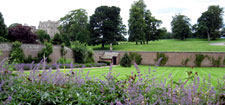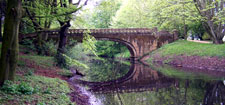Designed Landscapes
Historic parks and gardens are an important part of the County’s cultural heritage and are often of considerable scenic value. Some are of medieval origins, others surround the later country houses of larger landowners and industrial entrepreneurs. Historic parks and gardens are a living record of the evolving aesthetics of English landscape design. They are also often of nature conservation value because of their age, physical structure, or continuity of management, and contain some of the county’s most notable ancient and veteran trees.
English Heritage has compiled a Register of Parks and Gardens of Special Historic Interest, 13 of which are in County Durham. Development plans contain policies for the protection of the historic interest and special character of parks and gardens, and a number are also designated as, or fall within, Conservation Areas. The register is currently subject to review and further sites within the county may be included in future.
Issues and Objectives
Recognition and Protection
While some historic parks and gardens are recognised and protected in some degree by policies in local plans, many are not. The County Durham Landscape Assessment has identified a large number of parklands, relic parklands and ornamental gardens, most of which are not registered or covered by any protective designations or policies.
Objectives
- To develop and maintain a record of the county’s designed landscapes.
- To encourage appropriate levels of protection for designed landscapes in local development frameworks.
Neglect and Decline
Many historic parks and gardens no longer function as recreational landscapes and their features survive only as relics on land that is now managed for other purposes. There may be little incentive to invest in the upkeep of relic features like park walls, iron railings, ornamental lakes and buildings, ha-has, formal copses, walled gardens, and veteran avenue and parkland trees. These features are therefore often neglected and in progressive decline.
Objectives
- To encourage the conservation, management and restoration of designed landscapes and landscape features.
Development Pressure
Historic parks and gardens, and the buildings associated with them, are often under pressure for the development of new or alternative uses. While new development can bring resources for managing them sustainably in the future, it needs to be carried out in a way which is sensitive to their special character and historic interest.
Objectives
- To encourage, and provide guidance on, sensitivity in the development in designed landscapes
Veteran Trees
The county’s historic parks and gardens contain some of its oldest trees. The physical structure of parkland is often similar to that of wood pasture and can be important for species associated with old trees and mosaics of woodland and grassland, and particularly certain dead-wood invertebrates, fungi, hole-nesting birds and bats. Veteran and ancient trees are particularly vulnerable to damage from livestock, soil compaction and cultivation. They are also often seen erroneously as being ‘dead’ ‘dying’ ‘diseased’ or ‘over-mature’ and are therefore susceptible to being felled or heavily pruned on safety grounds.
Objectives
- To develop and maintain a record of notable, veteran and ancient parkland trees
- To encourage the sensitive management of veteran and ancient trees.



